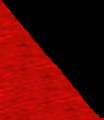| This classic
adoption narrative
was reprinted by Northeastern University Press in 2001.
Our children never thought of themselves as looking particularly
different from each other. One day, when Donny was eight and Alex
a year old, Donny crouched on the floor to encourage his little
brother to walk. Alex reached out both hands, took a hesitating
step, and tumbled into Donny’s arms. The high-pitched giggle
interlaced with the hearty boy-sized chuckle, then Donny looked
up at me, blue eyes wide and sincere under his thatch of blond hair.
“Mama,” he said, glancing fondly at the Oriental ivory
face beside him, at the black appleseed eyes that crinkle into slits
when Alex laughs, “if he was seven years older, and if I had
black hair, everybody would think that him and me was twins!”
They felt that much alike, our children, and often they took it
for granted that this alikeness would show. Naturally they could
see that there were minor and inconsequential variations, that Rita
had “the blackest, shiniest hair,” that Teddy could
toast browner in the sun than the rest, but persons bearing such
unearned distinctions were polite enough not to gloat. There are
only two times I can remember when differences within our family
seemed to be of any concern, and then, each time, it was only because
a small child developed a sudden fear that a minor dissimilarity
might be a physical handicap to the bearer. Once Teddy looked into
the mirror at his own brown eyes and then studied Donny, solicitude
puckering his face like a walnut.
“Donny?” he asked, “how can you see out of blue
eyes?”
Also there was the early-winter day when Timmy watched Carl trim
brown spots from apples with the point of a knife.
“Why do you do that, Daddy?” he asked.
“Bad spots,” Carl said.
Later I noticed Timmy staring at me, his usually frolicking brown
eyes now worried. “Daddy gonna cut pieces out of you?”
“Heavens, no,” I laughed. “What made you say
that?”
His fingers slid gently over the freckles on my arm. “Bad
spots,” he said.
It is the outsiders who imagine that our family is made up of incompatible
opposites. Those who have never ventured beyond the white bars of
their self-imposed social cages too often take for granted that
a different color skin on the outside makes for a different kind
of being, not of necessity completely human, on the inside. . . .
Some of the skeptical find it hard to believe that people of all
races are born with the same kind of vocal chords for speech, the
same kind of taste buds in the tongue, the same type of digestive
apparatus capable of assimilating a wide variety of foods. Differences
between national or racial groups are mostly just differences in
culture. It is not heredity but a cultural pattern that makes the
British love their royalty, the Chinese reverence their scholars,
and the Eskimos relish partially decomposed and frozen raw fish.
Cultural mores, not genes, determine the language we speak, our
notions as to the wearing of a sarong, a kilt, or a stuffy business
suit, and whether or not we think it polite to belch after a meal.
We try to explain these things, whenever we think the backs of
the misinformed are strong enough to bear the truth; but the boners
go marching on. One afternoon a businessman was talking to Carl
at our front door. Rita whizzed down the driveway sloping from the
church to the road, made too sharp a turn and flew off her trike,
landing square on her nose.
“Wow,” Carl said, poised to take off at the first wail
from down below. “My daughter took quite a spill.”
But there was no wail. Teddy was beside her in an instant, helping
Rita brush herself off. They giggled as both hopped back on their
tricycles and sped off around the circle drive again.
Carl relaxed and smiled. “I thought she was going to yell
her head off from that bump. She’s a tough little kid, though,
and a good sport.”
The man shrugged. “Actually, coming from such a primitive
stock, she couldn’t possibly have felt it the way a Caucasian
would have. I doubt if her nerve endings are very highly developed.”
Primitive nerve endings! Our children don’t need the studious
anthropologists and ethnologists to tell them that such fantastic
notions are hogwash, because they already know that people are more
alike than different; nor do they need the proof of microscopes
and IQ tests and statistics covering years of careful research,
to believe that modern science finds no race superior to any other.
|



